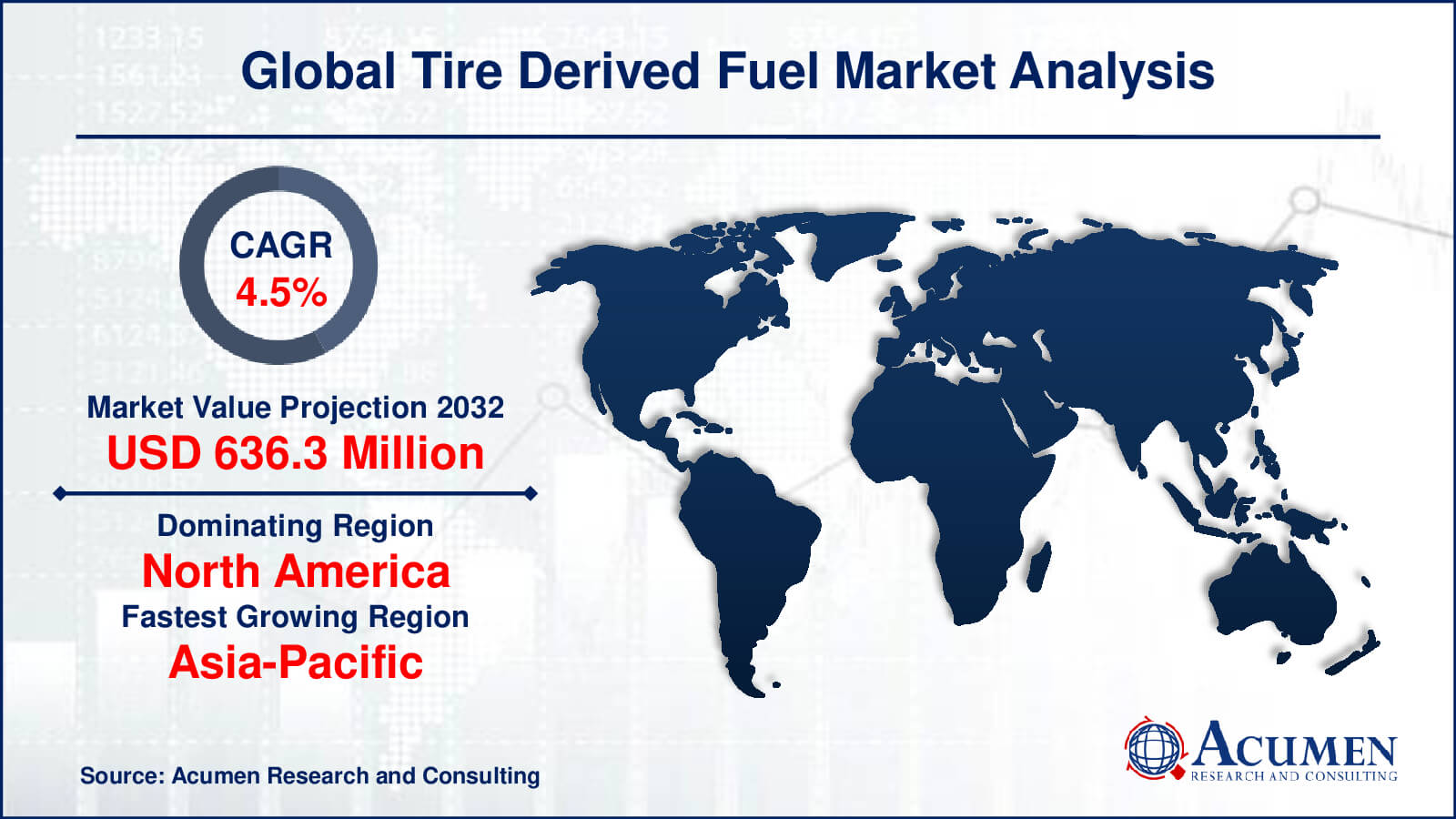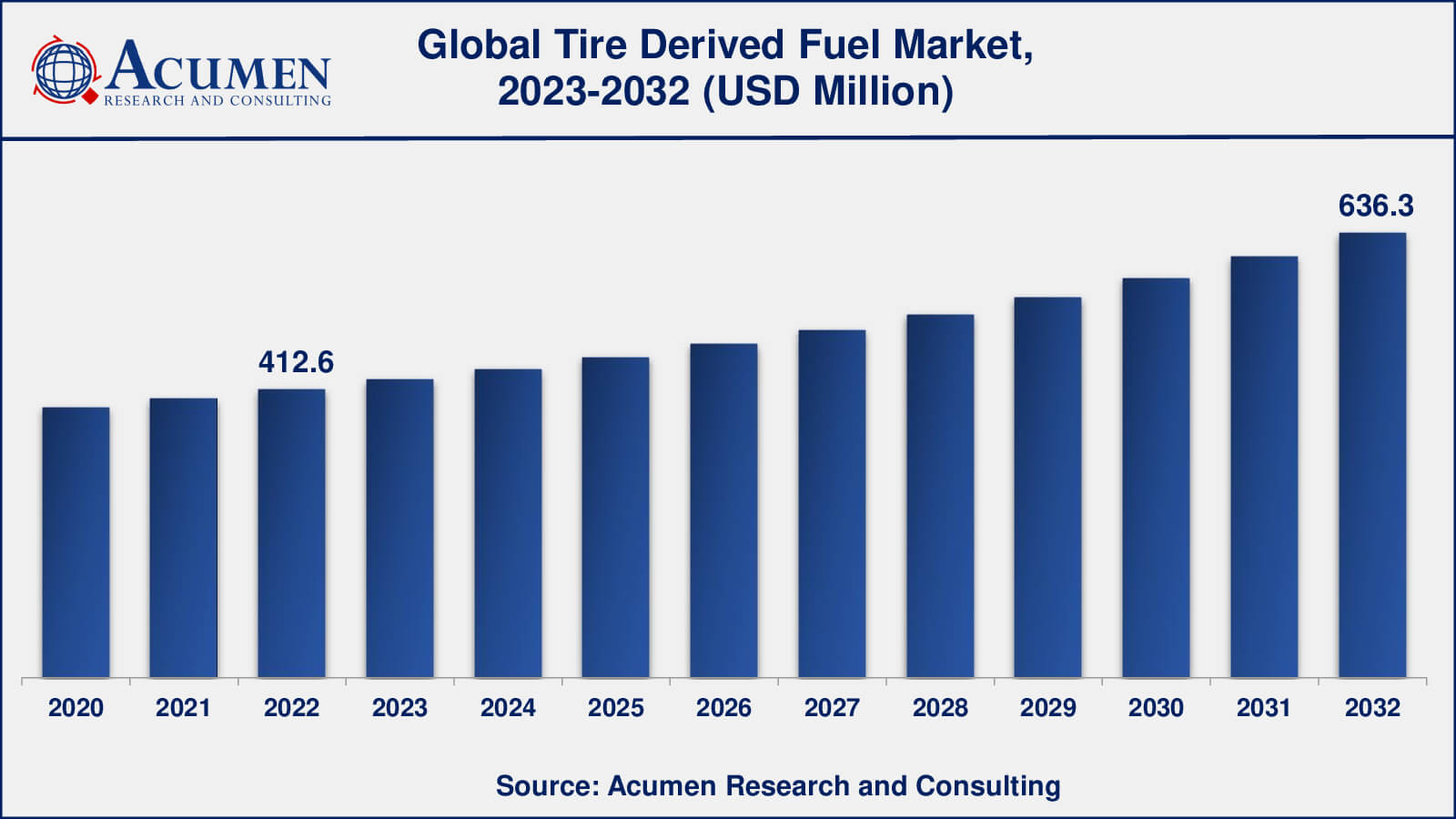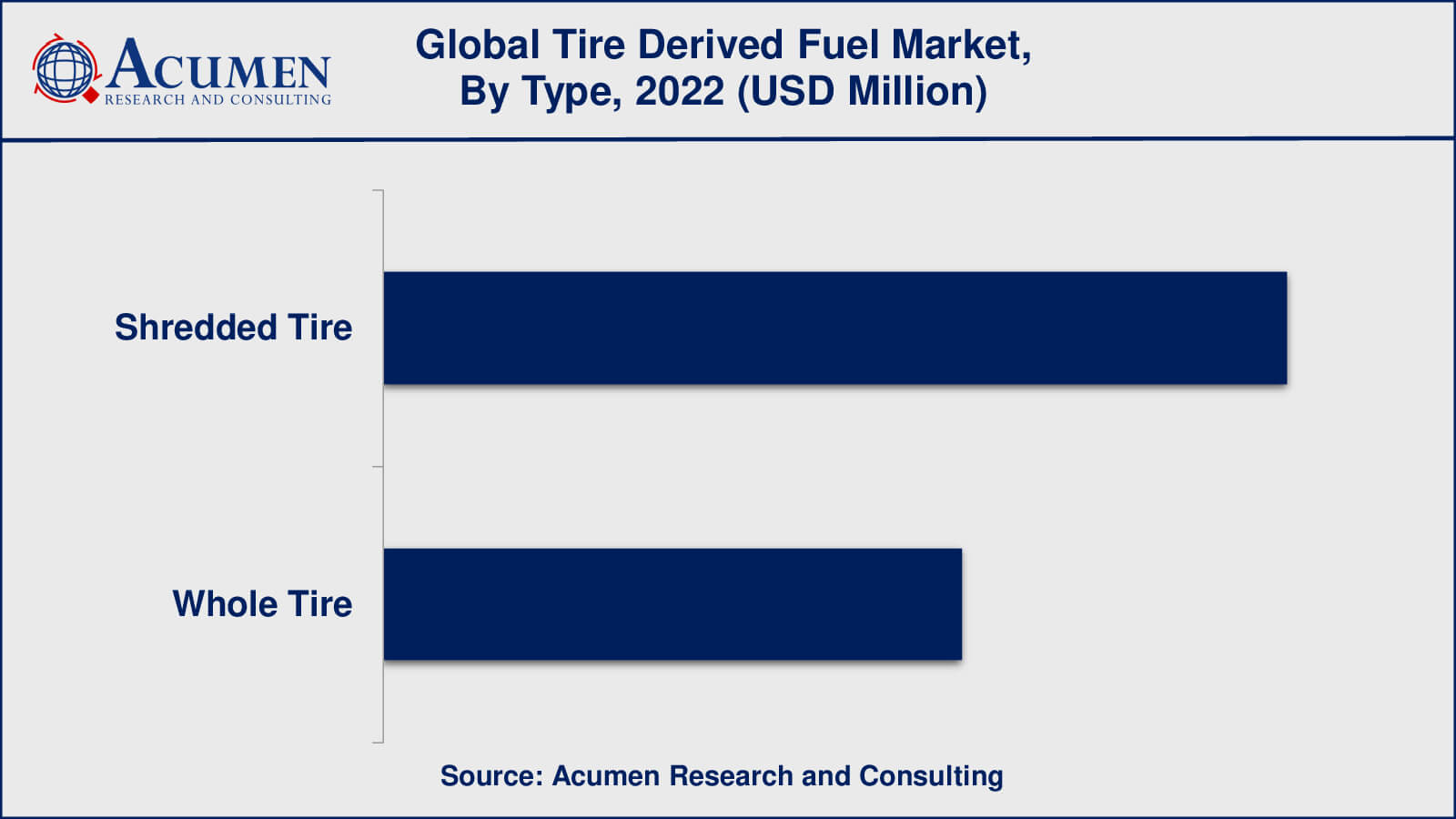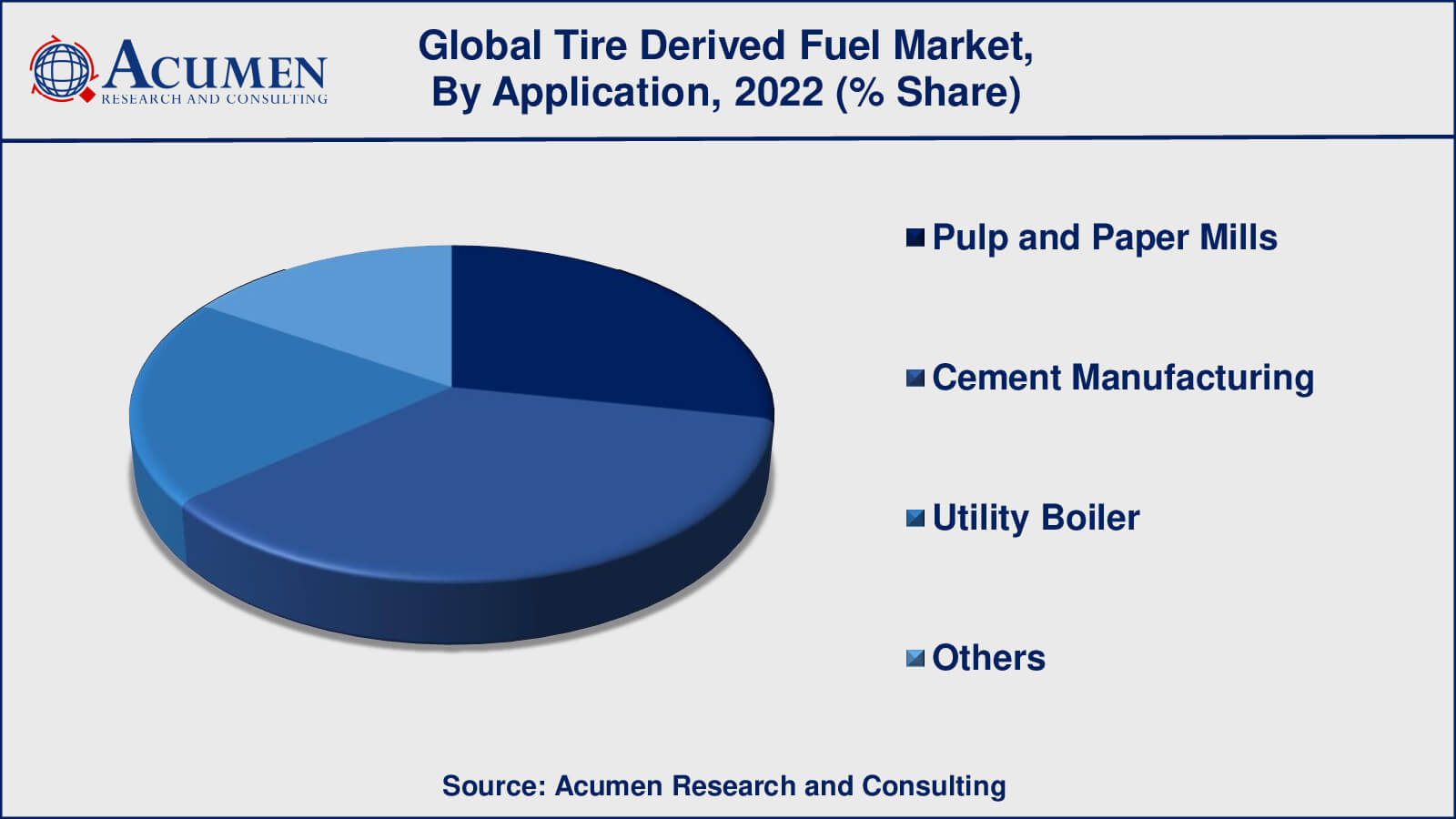November 2022
Tire Derived Fuel Market size was valued at USD 412.6 Million in 2022 and is projected to attain USD 636.3 Million by 2032 mounting at a CAGR of 4.5% from 2023 to 2032.
The global Tire Derived Fuel Market size was valued at USD 412.6 Million in 2022 and is projected to attain USD 636.3 Million by 2032 mounting at a CAGR of 4.5% from 2023 to 2032.
Tire Derived Fuel Market Highlights

Tire derived fuel (TDF) is the use of shredded or chipped tires as a fuel source in a variety of industrial operations. TDF is a feasible alternative to traditional fossil fuels like coal and oil, and it has various advantages. To make TDF, used tires are first treated and shrunk or chipped to minimize their size. The tire fragments that result can subsequently be utilized as fuel in cement kilns, paper mills, power plants, and other industrial facilities.
TDF's high energy content is one of its key benefits. Tires are made of rubber, which carries a lot of energy that may be released upon burning. Industries may tap into this energy source and lessen their dependency on traditional fuels by using TDF. TDF can also aid with the problem of waste tire disposal. Given the vast amounts of Tires produced worldwide, finding ecologically acceptable and sustainable disposal techniques is critical. Instead of allowing Tires to amass in landfills, TDF provides a solution by transforming them into a useful resource.
The usage of TDF may potentially have environmental advantages. TDF emits fewer greenhouse emissions than other fossil fuels when used correctly in controlled combustion systems. Furthermore, employing TDF in industrial operations can minimize the need for coal and oil, which contributes to natural resource depletion and pollutant emissions. Industries may contribute to a more sustainable and circular economy by encouraging the usage of TDF.

Global Tire Derived Fuel Market Dynamics
Market Drivers
Market Restraints
Market Opportunities
Tire Derived Fuel Market Report Coverage
| Market | Tire Derived Fuel Market |
| Tire Derived Fuel Market Size 2022 | USD 412.6 Million |
| Tire Derived Fuel Market Forecast 2032 | USD 636.3 Million |
| Tire Derived Fuel Market CAGR During 2023 - 2032 | 4.5% |
| Tire Derived Fuel Market Analysis Period | 2020 - 2032 |
| Tire Derived Fuel Market Base Year | 2022 |
| Tire Derived Fuel Market Forecast Data | 2023 - 2032 |
| Segments Covered | By Type, By Tire Source, By Application, And By Geography |
| Regional Scope | North America, Europe, Asia Pacific, Latin America, and Middle East & Africa |
| Key Companies Profiled | Global Tire Recycling, L & S Tire Company, Lakin Tire West, Liberty Tire Recycling, Ragn-Sells Group, Reliable Tire Disposal, Renelux Cyprus, ResourceCo, Scandinavian Enviro System, and Tire Disposal & Recycling. |
| Report Coverage |
Market Trends, Drivers, Restraints, Competitive Analysis, Player Profiling, Covid-19 Analysis, Regulation Analysis |
Tire Derived Fuel Market Insights
Several main aspects drive the tire-derived fuel (TDF) market business. Primarily, due to worries about climate change and the depletion of fossil fuel supplies, there is a growing need for alternative fuels and renewable energy sources. TDF is an appealing alternative since it provides a sustainable and easily available energy source, decreasing dependency on traditional fossil fuels like coal and oil. In addition, rising worries about waste tire disposal and environmental sustainability are propelling the tire derives fuel (TDF) market. Tires constitute a big difficulty in terms of proper disposal since they can take up space in landfills and have negative environmental consequences. TDF addresses this issue by transforming tires into a useful fuel resource, decreasing landfill waste and encouraging a circular economy.
Then again, TDF's potential cost savings and energy efficiency contribute to its market growth. Because of the existence of rubber, tires have a high energy capacity, and using TDF allows businesses to tap into this energy source. This can result in cost reductions for enterprises, particularly in areas where TDF can replace or enhance existing fuels, such as cement kilns, paper mills, and power plants.
Despite the favorable drivers, the tire-derived fuel TDF market confronts certain challenges. Important concerns include regulatory hurdles and compliance requirements linked to pollution and safety. To ensure that TDF combustion does not result in the production of dangerous pollutants or poisons, certain rules and norms must be followed. Meeting these regulatory criteria might increase expenses and provide obstacles for tire derived fuel TDF market enterprises.
Furthermore, the limited infrastructure and availability of TDF processing facilities might stifle industry expansion. Tire shredding or chipping technologies are used to convert tires to TDF, and not all places may have the appropriate equipment or infrastructure for successful tire processing. This constraint may have an influence on the general acceptance and use of TDF as an alternative fuel source. The TDF market, on the other hand, offers several potential for expansion. Emerging economies, in particular, hold great potential for increasing TDF use. As these economies grow, the need for energy rises, making TDF an appealing alternative for meeting their energy demands in a sustainable manner.
TDF market prospects are also provided by technological developments in tire shredding and combustion systems. TDF's attractiveness and competitiveness as a fuel source may be enhanced through innovations that improve the efficiency and efficacy of tire processing and combustion. Collaborations among tire producers, energy providers, and waste management organizations can also help to advance the development of sustainable tire disposal options. These stakeholders can encourage ethical TDF use, improve efficient supply chains, and create a more strong and sustainable tire derived fuel TDF market by working together.
Tire Derived Fuel Market Segmentation
The worldwide market for tire derived fuel is split based on type, tire source, application, and geography.
Tire Derived Fuel Types

According to the tire derived fuel industry analysis, the shredded tire type dominates the tire derived fuel (TDF) market. When compared to entire tires, shredded tires are more typically utilised as fuel. Shredding tires into smaller pieces improves their combustion qualities while also making them easier to handle and carry. The shredded tire shape has a larger surface area, which promotes effective burning and energy recovery. Furthermore, shredding tires eliminates any steel or other impurities, making them more appropriate for burning in industrial operations. Overall, the usage of shredded tires as TDF has gained traction and is more common in the market than entire tires.
Tire Derived Fuel Tire Sources
Heavy-duty vehicles are the most common tire source in the tire derived fuel (TDF) industry. Heavy-duty vehicles, such as trucks, buses, and construction equipment, often have bigger tires and consume more gasoline. When these tires are abandoned, they generate a substantial amount of waste tires that may be converted into TDF. Heavy-duty car tires are ideal for shredding and converting into fuel for industrial operations due to their size and composition. While small motor vehicles, motorbikes, aviation, bicycles, and other sources contribute to the TDF industry, waste tires from heavy-duty vehicles are the market's major tire source due to their volume and availability.
Tire Derived Fuel Applications

According to the tire derived fuel market forecast, cement manufacturing dominates the tire derived fuel (TDF) market. Cement kilns, which are used in the production of cement, have been a major application for TDF. The high temperature and long residence time in cement kilns provide an ideal environment for the combustion of TDF. The energy content of TDF can be effectively utilized in cement kilns, reducing the demand for traditional fossil fuels such as coal. The cement industry has been actively adopting TDF as a fuel source due to its energy efficiency, cost-effectiveness, and potential environmental benefits.
While pulp and paper mills, utility boilers, and other applications also utilize TDF, cement manufacturing has been at the forefront of TDF adoption. However, it is worth noting that the relative dominance of applications may vary depending on regional factors, industrial practices, and regulatory frameworks.
Tire Derived Fuel Market Regional Outlook
North America
Europe
Asia-Pacific
Latin America
The Middle East & Africa
Tire Derived Fuel Market Regional Analysis
North America has been an important market for TDF, owing to strict environmental restrictions, a growing emphasis on sustainable waste management, and the existence of modern waste-to-energy infrastructure. TDF is being used extensively in sectors like as cement manufacture, pulp and paper mills, and utility boilers in the United States, in particular.
Europe has been in the forefront of TDF adoption due to its strong emphasis on waste management and renewable energy. Several European nations have laws and regulations in place to encourage the use of TDF as a fuel source. Germany, Sweden, and the Netherlands all have well-established TDF markets, with cement manufacture being the most common use.
The Asia-Pacific region's TDF market is expanding rapidly, owing to rising industrialization, urbanization, and waste tire creation. China, India, and Japan are aggressively researching TDF as an alternative fuel source in order to lessen their reliance on traditional fossil fuels. TDF's primary uses in this region are in the cement and power generating industries.
Tire Derived Fuel Market Players
Some of the top tire derived fuel companies offered in our report include Global Tire Recycling, L & S Tire Company, Lakin Tire West, Liberty Tire Recycling, Ragn-Sells Group, Reliable Tire Disposal, Renelux Cyprus, ResourceCo, Scandinavian Enviro System, and Tire Disposal & Recycling.
Tire Derived Fuel Industry Recent Developments
Looking for discounts, bulk pricing, or custom solutions? Contact us today at sales@acumenresearchandconsulting.com
November 2022
February 2024
April 2025
December 2022